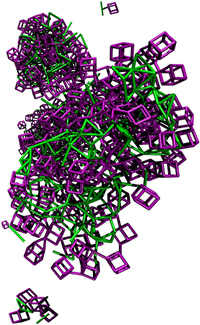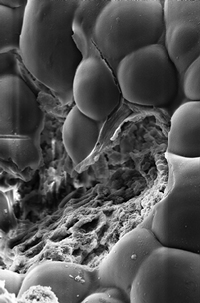MSc Projects
Emergent Behaviour in the Self-Assembly of Metal-Organic Frameworks
My first Complexity MSc project is entitled Nucleation of Different Polymorphs: Emergent Behaviour in the Self Assembly of Metal-Organic Frameworks, and is supervised by Prof. Mark Rodger, in Warwick's Chemistry Department.
Metal-organic frameworks are crystalline compounds incorporating nanometer-sized pores in their structure. The porosity of these materials can lead to interesting applications : they can serve as molecular sieves for drug purification, hydrogen storage media in the energy industry or in the sequestration of carbon dioxide. Metal-organic frameworks can form different framework topologies, and our understanding of the factors that lead to a particular structure is limited. Using dynamical simulation methods, our aim is to model the emergence of difference network topologies using a coarse-grained model to represent the secondary building blocks that make up the metal-organic framework. Analysis of the simulations will help reveal some of the important factors in the nucleation of various network topologies.
I have produced a poster which summarises my research midway through the project, and a final report covering the entirety of the project.
Quantitative Descriptors of Drosophila Eye Phenotype
My second project is with Dr. John Aston in the Department of Statistics and Prof. Bruno Frenguelli in the Department of Life Sciences at Warwick, and is entitled Replacing the Fuzzy with the Hard: Quantitative interrogation of Drosophila eye phenotype in the context of Alzheimer's Disease.
Drosophila, the common fruit fly, is a model organism with well-understood genetics and behaviour. Human genes can be inserted into the fruit fly to examine the consequences of the protein-protein interactions responsible for human diseases. In this research, we assess the extent to which neurofibrillary tangles, formed by expression of hyperphosphorylated tau protein in the eye, causes distortion in the otherwise regular structure of the compound eye. The aim of this project is to create quantitative descriptors of the appearance of the Drosophila eye in order to make statistically rigorous assessments of the distortion in the geometry induced by the proteins linked to Alzheimer's in humans.
My final report discusses the end results of this project, and this poster summarising my research was presented at the European Conference for Complex Systems 2009 in September.
A software package, Quantitative Evaluation of Distortion (QED) was the final result of this project, which implements the methodology described in the project, incorporating a GUI for easy user control. It was written in MATLAB for Windows systems, though the source is available for Linux systems.
A paper is in the process of being written, with submission coming soon !


